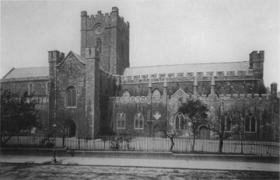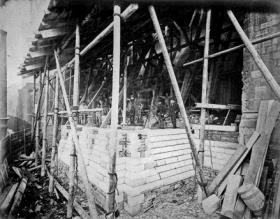Restoration 1878
Published in 18th–19th - Century History, General, Issue 6 (Nov/Dec 2008), Medieval History (pre-1500), News, Volume 16
Left: Christ Church Cathedral as it appeared before Street’s restoration of 1871–8. The long choir (to the right) and the squat crossing tower are strikingly different to its appearance today. (National Library of Ireland)
Christ Church Cathedral, Dublin, was founded c. 1030 by Sitriuc, king of the Dublin Danes, when Dunán was bishop. In the following century, when the occupant of the see of Dublin had been elevated to the rank of archbishop, Lorcán Ua Tuathail (a.k.a. St Laurence O’Toole) established a priory of Augustinian canons there. After the Anglo-Norman invasion, the original wooden building was reconstructed in stone in the Romanesque manner by Richard de Clare (Strongbow). Within a century, the Norman building had given way to the Gothic cathedral. At the sixteenth-century Reformation, thanks to the intervention of some of the city’s leading citizens, the priory escaped the fate of most Irish religious houses, and survived as a ‘secular’ cathedral—the Augustinian prior and canons continuing in place, but now as dean and chapter. The personnel remained the same, but from now on worship at Christ Church was according to the rites of the Book of Common Prayer.
In 1562 a catastrophe struck: the roof and most of the south side of the building collapsed. It was patched up, and for several centuries Christ Church was a somewhat unprepossessing patchwork of styles. But it continued to hold its place in the life of the capital and was, for instance, the Chapel Royal until Dublin Castle got its own place of worship. Christ Church was where ‘the government came to worship’—even under Cromwell. But it was, nonetheless, something of an architectural mess . . . until, in the 1870s, the dean and chapter engaged the eminent Victorian architect George Edmund Street to plan a full-scale restoration. When the Dublin distiller Henry Roe came up with the required funding (€30 million in today’s money), the project could be put in hand. By now the Church of Ireland had been disestablished and disendowed by the state, and became an independent church governed by a general synod. Street and Roe gave the Church of Ireland a Synod Hall (now home of the Viking and medieval museum, Dublinia), joined to the cathedral by the Venetian-style bridge that has become one of Dublin’s architectural icons.
Street’s reconstruction of Christ Church was highly controversial, as such restorations tend to be. While his claim that he was reinstating the cathedral as it had been centuries before would be disputed by today’s scholars, more of the original building survives than was once recognised. When the cathedral reopened for public worship 130 years ago in May 1878 (having been closed for several years while the work was in progress), there were many expressions of wonder and admiration . . . as well as some critical voices.

The north side of the nave during reconstruction. Street rebuilt the failing arcade piers while retaining the upper elevation in place, seen here propped up on massive baulks of timber. (National Library of Ireland)
Beginning with a History of Christ Church Cathedral, Dublin (2000), the cathedral has embarked on a major publishing project with Four Courts Press, including the ‘Christ Church History’ series, accompanied by a CD of documents and selected anthems edited by Barra Boydell, who also produced Music at Christ Church Cathedral, Dublin. Among the publications were Raymond Gillespie’s (general editor of the series) and Raymond Refaussé’s The medieval manuscripts of Christ Church Cathedral, Dublin, and Stuart Kinsella’s Augustinians at Christ Church.
In the course of the research an enormous amount of material, both textual and illustrative, has come to light. Particularly exciting has been the discovery in the National Library of a cache of photographs showing the restoration work in progress, with images of Christ Church ‘before’ and ‘after’. These photographs form part of an exhibition, ‘Restoration 1878’, now running in the cathedral crypt under the care of Dr Michael O’Neill. He has also arranged a display in the north transept of medieval stone carvings that Street found no use for but that were preserved. Both of these exhibitions, together with the cathedral treasury (including the tabernacle used when James II attended Mass at Christ Church in 1689 and the silver plate presented by William III in thanksgiving for his victory at the Boyne), do much to highlight the colourful story of a place where public worship has been offered for almost a thousand years.
Kenneth Milne is chairman of the Christ Church Cathedral Culture Committee and author of A short history of the Church of Ireland (Columba Press, 2003).
















